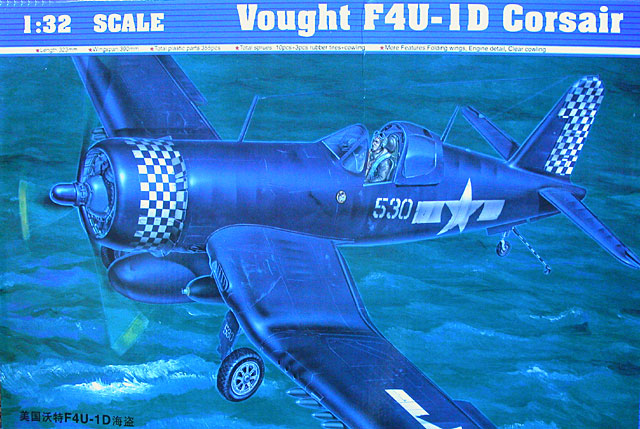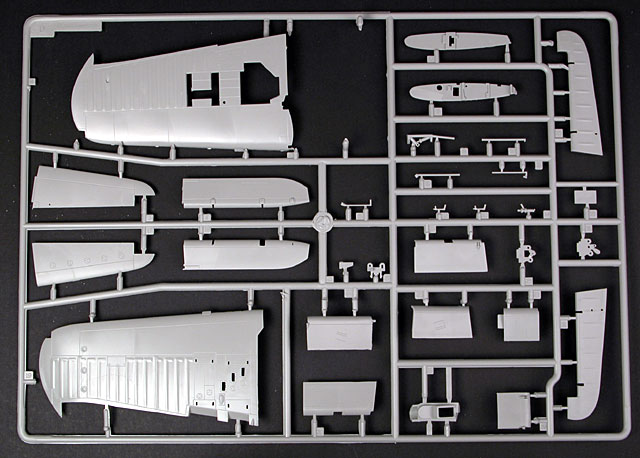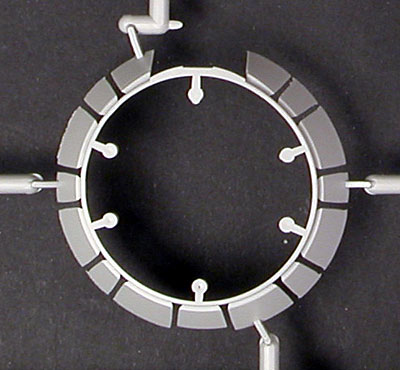|
F4U-1D Corsair

Trumpeter
S
u m m a r y
|
| Catalogue Number: |
02221 |
| Scale: |
1/32 |
| Contents and Media: |
355 parts in light grey and clear
injection moulded plastic; metal shafts for ailerons and flaps; rubber
tyres; photo-etched parts for control surface hinges; markings for two
aircraft |
| Price: |
Purchased for ¥6,500 |
| Review Type: |
QuickLook |
| Advantages: |
Outline and appearance conforms to
published plans, photos and existing kits; high quality mouldings; ambitious workable
features including all control surfaces and wing folds; well detailed
R-2800 engine; much more restrained surface details (rivets etc) than
earlier releases. |
| Disadvantages: |
Inaccurate cockpit (solid floor
included); slightly gap-toothed look to open cowl flaps. |
| Recommendation: |
Recommended. |
Previewed
by
Brett Green

HyperScale is proudly supported by Squadron.com
Trumpeter's remarkable release juggernaut rolls on with their
1/32 scale F4U-1D Corsair.
This is a sensible choice for the first Corsair release, as the
-1D variant saw service in both WWII and Korea, has ample stores options, and is
relatively easy to backdate to a -1A.
Trumpeter's 1/32 scale F4U-1D Corsair comprises 355 injection
moulded parts in grey plastic and clear styrene (including a clear cowl), rubber
tyres, a small bag of metal rods, a photo-etched fret with hinges for control
surfaces and an acetate sheet with printed instruments.
The surface of previous releases have been covered with recessed
rivets. On the Corsair, the rivets have been greatly reduced in quantity;
appearing in single rows along selected panel lines. I know that this is largely
a matter of taste, but it looks much better to my eye.

Click the thumbnails below to view
larger images:
Fabric texture on the rudder and ailerons are much more subtle
than earlier offerings, but the wing outer panels are overemphasised. A few
minutes sanding will help.

The overall quality of the moulding is very good. Ejector pin
marks have mainly been confined to the invisible rear surfaces of parts with
only a few exceptions (such as the wing fold interiors). There are some shallow
sink marks at the base of the propeller blades.
Control surfaces are movable, including the four separate flaps.
Each control surface is connected using a brass rod and photo-etched hinges. The
foot-step in the starboard inner flap is not a cut-out. It is accurately
outlined with recessed panel lines, .
The wings folds are also workable. Each is hinged via a single
narrow attachment point, so care will be required when handling the model and
operating the wing fold. Many modellers will choose to glue the wings in
position - either folded or extended. The wings also feature separate access
hatches for the .50 cal machine guns and ammunition trays.
The tail wheel and hook are retractable. The main gear legs are
not "sprung" this time (a move in the right direction, in my opinion), but the
oleo struts are supplied as separate parts that are inserted in the upper part
of the gear legs. The struts are located with a small pin, but the modeller
could easily cut off the pin and reposition the overall length of the gear legs
if desired.
Tyres are rubber.
The cockpit is fairly typical of earlier releases. Detail is
adequate but the basic parts will benefit from extra detailing in this large
scale. The biggest problem is the full floor as supplied by Trumpeter. The
Corsair had no cockpit "floor" as such. The seat was attached to the rear
bulkhead, and the pilot's footrails were the only metal between the pilot and
the bottom of the fuselage. Also, the kit seat has a few nasty ejector pin marks
that will be hard to reach.
Verlinden already offers a 1/32 scale resin replacement cockpit
for the old Revell Corsair kit; and Eduard has a comprehensive photo-etched set,
but I have no way of knowing whether these will fit the Trumpeter kit. However,
I think we can safely assume that at least one after-market company will come to
the rescue with a brand new resin cockpit
Detail in the engine is very good. Almost eighty parts go into this busy-looking
R-2800, including all the appropriate pushrods and plumbing. There is no
ignition harness supplied, but an hour or so with some fuse wire and a pin vise
will fix that omission.
 A
single-piece open cowl-flap ring is included. The cowl flaps look a little
gap-toothed, with even spaces between each flap, even at the hinge line. Adding
a wedge of plastic sheet behind each gap will go a long way toward addressing
this issue. A
single-piece open cowl-flap ring is included. The cowl flaps look a little
gap-toothed, with even spaces between each flap, even at the hinge line. Adding
a wedge of plastic sheet behind each gap will go a long way toward addressing
this issue.
Plenty of stores are provided - two bombs, eight rockets and two
drop tanks.
The transparent parts look good too, being thin and clear.
|
Home | What's
New | Features
| Gallery |
Reviews | Reference
| Forum
| Search